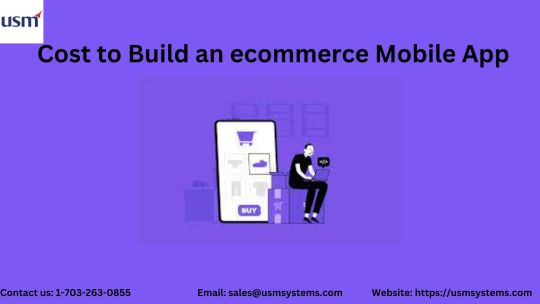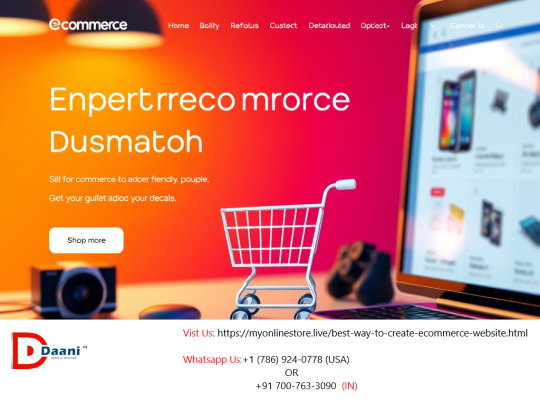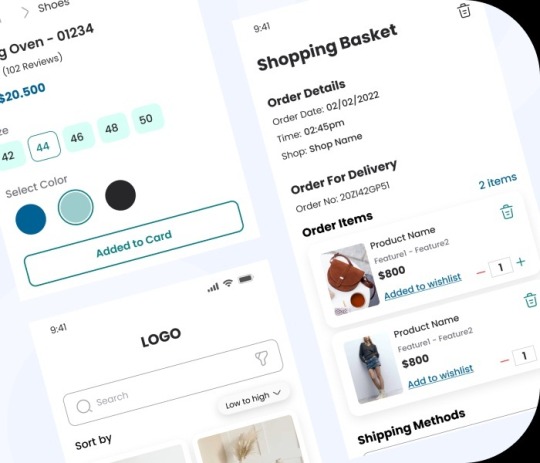#ecommerce app builder
Explore tagged Tumblr posts
Text
Best Mobile App Builder For eCommerce Platform
MageNative is the best mobile app builder in the market for your eCommerce platform. The best thing is, it is a no-code mobile app builder. We bring to you native apps that are built to scale and enhance your business, bringing aesthetics and simplicity of design in the easiest and smartest way possible.
#mobile app#mobile app builder#app builder#native app#app maker#build mobile app#app mobile#mobile builder#mobile app maker#shopify mobile app#no code mobile app builder#ecommerce app builder#create mobile app
3 notes
·
View notes
Text
How to Choose the Right Framework for Ecommerce App Development
Choosing the right framework for e-commerce app development is essential for success. Evaluate factors such as scalability, security, and developer experience. Consider React Native for cross-platform capability or Flutter for fast development. Ensure the framework supports essential features like payment integration and a user-friendly design. Assess community support, documentation, and updates for a framework that fits with your project needs and business goals.
#eCommerce App Development#ecommerce app builder#ecommerce app development company#ecommerce app development services
0 notes
Text
eCommerce mobile app builder for shopify stores Discover an eCommerce mobile app builder for shopify stores. With user-friendly interfaces and customizable features, this platform empowers businesses to create intuitive mobile shopping experiences, driving sales and customer engagement effortlessly.
#ecommerce website development#eCommerce App Builder#iOS Shopping App Builder#eCommerce stores builder#Mobile App Creation#App Building Platform#Mobile App Solutions#Custom mobile app builder for eCommerce#Turn eCommerce store into a mobile app
1 note
·
View note
Text
Cost To Develop An Android Ecommerce-App & Features

The popularity of creating mobile apps has increased recently. It is evident in every industry sector, including eCommerce, from healthcare to retail. Nowadays, people depend more and more on smartphone applications for nearly everything, such as food delivery, online shopping, and binge-watching TV shows or movies.
Mobile apps help expand brand awareness, improve market communication, higher conversion rates, and more. eCommerce apps account for 72.9% of the mobile app market, according to Statista. As a result, several business owners from different industries are investing in developing eCommerce apps.
People spend most of their time on smartphones and use multiple apps every day. Therefore, creating an eCommerce app can benefit your business as it will create brand awareness. Moreover, it can enhance user interaction due to 24*7 availability.
Every retailer should inquire about project costs before selecting an eCommerce app development provider.On his blog, he lists the eCommerce app development features that cost the least.
Note: To build an ecommerce app, you can contact Android application development companies in Virginia
Let’s go through the obvious business benefits of using an eCommerce mobile app-
Effective Marketing- ECommerce mobile app serves as a cost-effective and highly effective marketing tool. It not only meets the shopping needs of your customers but also allows you to come up with app-based discounts and real-time promotional notifications. In a sense, an eCommerce app for Android and iOS can boost customer loyalty.
Information Collection- The eCommerce app requires the user’s email ID and social media account details along with their contact numbers. As a result, eCommerce companies can obtain valuable data from their existing and potential customers.
Improved collaboration- A customized eCommerce mobile app facilitates secure and real-time collaboration between your company and customers. In addition to searching or shopping anytime, the app allows your customers to ask questions or give advice 24/7.
Spread Brand Awareness- Mobile app development company in USA creates an app that fits your business model, thus helping you increase your brand visibility. E-commerce apps with a personalized experience can be an excellent tool for effective communication with customers.
While eCommerce apps offer many benefits to businesses and startups, still many business people have no idea about the cost of developing eCommerce apps. Let’s dig deeper into this in this blog.
Selecting the Features First
Prioritizing your options wisely is essential when creating an e-commerce app because they have a big impact on the project's overall cost. Giving the necessities top priority and gradually introducing the newest items through features will help you get the most out of your money.
Customer onboarding: The capacity to sign up customers is among the most crucial components of a mobile commerce platform. You can allow users to join up using their social network or email credentials or provide them guest access. To enhance the user experience and speed up app navigation, a client login page or simple instructions are advised.
Any mobile commerce app must include a search feature with numerous straightforward filtering options. Users should be able to locate exactly what they're looking for by using a variety of filters and search phrases.
Push notifications are a crucial component of e-commerce platforms since they can periodically send customers alerts, SMS messages, and promotions.
The majority of customer engagement and business conversion happens in a product catalog. As a result, a user-friendly, logically organized product page must be created.
User-Generated Content: People should be given the chance to vote, comment, and upload their own tales.
Unified payment system: Several quick and secure payment methods should be provided.
Users can put the things they want to buy in a cart.
In order to provide customers the flexibility and confidence they deserve, they must be able to verify the progress of their orders and deliveries. Users ought to have access to an order summary and a delivery timeline.
Two examples of more-common advanced features include voice chatbot support and GPS position monitoring. But it's crucial to keep in mind that these sophisticated features could significantly increase the price of first production development.
As a result, give the foundational information top attention and build up to more complicated ideas based on user input. Gradual development is the best method for producing profitable e-commerce software without going over budget.
What it will cost to create an e-commerce app in 2023
He asked how much a smartphone app costs. You are in the proper location. The average cost to create an ecommerce app is between $20,000 and $40,000. A number of variables, such as complexity, the number of platforms utilized for development, features, design, developer location, and ongoing support and maintenance of the app, can have a considerable impact on the price of an eCommerce app. To acquire a precise cost estimate, grasp the details better.
The size of the business
The quantity of goods sold and the number of clients a specific e-commerce app serves determine the app's size.
Little
A small e-commerce business has limited inventory and few customers that require limited hardware and good UI/UX design. An eCommerce mobile app costs anything between $300- $16000.
It is an average business
If the e-commerce app has a suitable variety of features and regular customers, then the business needs a mid-range app with some complex features. The cost of building a mid-sized e-commerce app ranges from $16,000- $35,000.
Related Article: Androidapp development company in Tacoma
Business at the corporate level
To manage massive stocks, several sales channels, and countless brands, an app with this many features and users needs a scalable solution. It's also crucial that CRM and ERP are integrated. Custom enterprise-level commerce software can be produced for as little as $40,000. The development of apps for the e-commerce sector falls within the corporate business category because it includes thousands of suppliers who provide a variety of services to millions of customers.
Place
The choice of platform has a significant impact on the overall cost of an e-commerce app. While Android has a large user base around the world, iOS is more popular in North America. An e-commerce app should be built according to targeted user base preferences that help you move towards financial profitability. When you build an Android eCommerce app, it costs about $25,000. On the other hand, developing an iOS eCommerce application costs $20,000. Building the app on both major platforms brings in a total of $45,000.
Author: I’m Anita Basa, a fascinating Technical Content writer currently working at USM Business Systems. Interested to know about technology updates. Mobile App Development, IoT, Artificial Intelligence, Machine Learning, IOS, and Technology-related content Get connected with me on Linkedin
#Ecommerce#ecommerceappdevelopment#ecommerceapp#ecommerce application development#ecommerce app builder#Ecommerce App Development#android app development#iOSAppDevelopment#mobileappdevelopmentusa#MobileAppDevelopmentCompanies#iOS App Development Companies#populer#Amazon#flipkart#ajio#myntra#Onlineshopping#online shops offer#online#business#onlinebusines#onlinebusinesses#marketing#enterprenuership#enterpreneur#sales#forsale#buying
1 note
·
View note
Text
The importance of developing e-commerce apps
For businesses looking to increase their customer base and revenue, e-commerce app development has become more and more crucial. Given that more and more consumers are switching to online shopping, having a mobile app that provides a seamless shopping experience is more important than ever.
With the help of an e-commerce app, customers can easily browse and purchase products using their smartphones, providing them with accessibility and convenience. Furthermore, it gives businesses the opportunity to compile insightful data on consumer behavior and preferences that can be used to better target marketing initiatives and improve the overall customer experience.
0 notes
Text
Reputable Ecommerce App Development Dubai Company | Code Brew Labs
The top ecommerce app development Dubai company, Code Brew Labs, is renowned for delivering superior and outstanding ecommerce app development UAE solutions. We provide cutting-edge solutions for creating personalized apps and have received numerous honors for them. Contact us immediately to receive the best ecommerce development services in Dubai.
#create ecommerce app#ecommerce app builder#ecommerce app development dubai#ecommerce development dubai#ecommerce development company dubai
0 notes
Text
"Every tap on your app is a step closer to brand loyalty—make it count with the right mobile app builder."
0 notes
Text

Starting an online business is both exciting and challenging. Many entrepreneurs dream of creating a successful ecommerce venture, but building the right website is essential. An effective ecommerce site can be a game-changer, helping you connect with customers and drive sales. With the proper tools and insights, you can create a professional-looking ecommerce platform that captures attention and converts visitors into loyal customers.
Understanding the E-commerce Landscape
Before you get started, it’s crucial to understand the ecommerce environment. The digital marketplace is expanding rapidly, with a recent report showing that ecommerce sales are projected to reach over $6 trillion by 2024. This growth indicates an increasing preference for online shopping over brick-and-mortar stores. Understanding your target audience is vital; for example, 67% of consumers prefer to shop online for convenience.
By studying their shopping habits and preferences, you can better tailor your website to provide an excellent user experience. Furthermore, analyzing your competition can reveal effective strategies and potential mistakes to avoid, giving you a competitive edge.
If you want to try our software, please click on the Easiest way to create e-commerce website.

#Best ecommerce app builder#best ecommerce website builder#online website builder#online ecommerce store apps#best app to create online store#best online store builder
0 notes
Text
0 notes
Text
Setting up and online shop website to sell products online
Non-customized e-commerce software is pre-packaged with essential features, providing users with a ready-made platform to showcase and sell their products or services online. The simplicity of these solutions is particularly appealing for those who may not possess advanced technical skills, offering an uncomplicated setup process that allows users to get their stores up and running swiftly.
One notable advantage of non-customized e-commerce software lies in its cost-effectiveness. With a predefined set of features, users can avoid the expenses associated with custom development while still accessing critical functionalities like secure payment gateways, inventory management, and order processing. This affordability makes non-customized platforms an attractive option for budget-conscious businesses aiming to establish a robust online presence.
Read More...

#Easy store website builder#Best ecommerce app builder#Best ecommerce website builder#Online website builder#Online ecommerce store apps#Best app to create online store#Best online store builder#Online business
0 notes
Text
How Ecommerce App Development Improves Visibility of Businesses
Ecommerce app development plays an important role in increasing the visibility of businesses in the digital world. With the increasing reliance on online platforms for shopping, a strong online presence has become essential for businesses. A well-designed and user-friendly ecommerce app can attract and engage customers, increasing visibility and higher sales. An ecommerce app allows businesses to reach their target audience beyond geographic boundaries.
0 notes
Text
How to Create a Mobile App Without Coding Skills: A Beginner's Guide

In today's tech-savvy world, having a mobile app for your business, hobby, or personal use has become increasingly popular. However, the misconception persists that developing an app requires advanced coding skills and technical expertise. Fortunately, thanks to advancements in technology, creating a mobile app builder has become more accessible to individuals without coding knowledge. In this beginner's guide, we'll explore the step-by-step process of creating a mobile app without writing a single line of code.
Understanding the Basics
Before diving into app development, it's essential to grasp the fundamentals. A mobile app is a software application designed to run on mobile devices such as smartphones and tablets. These apps can serve various purposes, from entertainment and productivity to e-commerce and social networking.
Why Create a Mobile App?
The benefits of having a mobile app are manifold. For businesses, it can enhance customer engagement, boost brand visibility, and generate additional revenue streams. For individuals, it provides a platform to showcase creativity, share knowledge, or simply solve everyday problems more efficiently.
Common Misconceptions
One of the most significant misconceptions about app development is that it requires extensive coding skills. While coding certainly plays a crucial role in traditional app development, there are now alternative methods that allow individuals to create apps without coding.
Choosing the Right Approach
When it comes to creating a mobile app without coding skills, there are several approaches you can take. Each approach has its own set of pros and cons, so it's essential to choose the one that best aligns with your goals and expertise.
App Builders and Platforms
App builders or app development platforms are online tools that provide a user-friendly interface for creating mobile apps without coding. These platforms typically offer drag-and-drop functionality, pre-designed templates, and built-in features that make app development accessible to beginners.
No-Code Development Platforms
No-code development platforms take app development a step further by eliminating the need for any programming knowledge whatsoever. These platforms typically use visual interfaces and pre-built components to enable users to create fully functional apps with minimal effort.
Planning Your App
Once you've chosen the approach that best suits your needs, it's time to plan your app. This involves defining its purpose, identifying its target audience, and outlining its features and functionalities.
Define Your App's Purpose
Before you start building your app, ask yourself: What problem does it solve? What value does it provide to users? Clearly defining your app's purpose will help guide its development and ensure that it meets the needs of your target audience.
Identify Your Target Audience
Understanding your target audience is key to creating a successful app. Consider factors such as demographics, interests, and pain points to tailor your app to the needs and preferences of your target users.
Outline Your App's Features
Make a list of the features and functionalities you want your app to have. Start with the essential features that are core to your app's purpose, then consider additional features that could enhance the user experience.
Designing Your App
The design of your app plays a crucial role in its success. A well-designed app not only looks good but also provides a seamless and intuitive user experience.
User Interface (UI) Design
The UI design encompasses the visual elements of your app, including layout, colors, typography, and graphics. Aim for a clean and intuitive design that makes it easy for users to navigate and interact with your app.
User Experience (UX) Design
UX design focuses on the overall experience of using your app, from the moment users open it to when they complete their desired actions. Pay attention to factors such as usability, accessibility, and performance to ensure a positive user experience.
Prototyping and Testing
Before finalizing your app design, create prototypes to visualize how it will look and function. Conduct usability testing with real users to gather feedback and identify any usability issues or areas for improvement.
Building Your App
Once you have a clear plan and design for your app, it's time to start building it using your chosen development platform.
Drag-and-Drop Interface
If you're using an app builder or no-code platform, take advantage of the drag-and-drop interface to add elements, customize layouts, and configure functionalities. Experiment with different features and settings to achieve the desired look and functionality for your app.
Customization Options
Most app development platforms offer a range of customization options, allowing you to personalize your app to reflect your brand identity and style. Take the time to explore these options and make your app stand out from the crowd.
Integration with Third-Party Services
Many app development platforms allow you to integrate your app with third-party services and APIs to add additional functionalities. Explore the available integrations and consider how they can enhance your app's features and capabilities.
Testing and Launching Your App
Before releasing your app to the public, it's essential to thoroughly test it to ensure it functions correctly and meets the needs of your users.
Beta Testing
Invite a small group of beta testers to try out your app and provide feedback. Look for any bugs, glitches, or usability issues that need to be addressed before the official launch.
App Store Submission
Once you're confident that your app is ready for release, submit it to the appropriate app stores (e.g., Apple App Store, Google Play Store). Follow the submission guidelines and requirements to ensure a smooth approval process.
Marketing and Promotion
Launching your app is just the beginning. To attract users and drive downloads, invest in marketing and promotion efforts such as social media campaigns, app store optimization (ASO), and influencer partnerships.
Conclusion
Creating a shopify mobile app builder without coding skills may seem daunting at first, but with the right tools, resources, and guidance, it's entirely achievable. Whether you're a business owner looking to expand your reach or an individual with a creative idea, the opportunities for app development are endless. By following the steps outlined in this beginner's guide, you can turn your app idea into reality and bring your vision to life. So what are you waiting for? Start building your dream app today!
#best no code mobile app builder#white label mobile app builder#no code mobile app builder#mobile app builder#best mobile app builder#shopify mobile app builder#ecommerce mobile app builder#online store app builder#shopify mobile app template#integrate shopify with android app#mobile app builder for shopify#best shopify mobile app builder
0 notes
Text

Best ecommerce mobile app builder: Apsy
Apsy, presents the best ecommerce mobile app builder. We offer the best mobile app creator. Reach out to us for web and mobile app development.
0 notes
Text
Boosting Sales and Satisfaction: Essential UX Design Tips for E-Commerce Apps
In the dynamic landscape of e-commerce, where user attention is scarce and competition is fierce, crafting a seamless and intuitive user experience (UX) is paramount. From the moment a visitor lands on your e-commerce app to the final checkout, every interaction should be smooth, engaging, and conducive to conversions. Here are ten indispensable UX design tips tailored specifically for e-commerce apps:
Streamline Navigation: Simplify the navigation structure by categorizing products logically and prominently displaying essential sections like home, product catalog, cart, and account. Implement intuitive icons and clear labels to guide users effortlessly through the app.
Optimize Search Functionality: Incorporate a robust search feature with predictive text, auto-suggestions, and filters to help users find products quickly. Implementing features like autocorrect and recognizing synonyms enhances the search experience, reducing friction and improving user satisfaction.
Prioritize Visual Content: High-quality images and videos are fundamental for showcasing products effectively. Ensure fast-loading media and offer multiple angles or zoom functionality to provide users with a comprehensive view of the products. Including user-generated content such as reviews and images can also enhance trust and engagement.
Responsive Design: With the proliferation of mobile devices, responsive design is no longer an option but a necessity. Ensure that your e-commerce app adapts seamlessly to various screen sizes and orientations, providing a consistent experience across devices. Test extensively to eliminate any usability issues on different platforms.
Seamless Checkout Process: Simplify the checkout process to minimize friction and cart abandonment. Implement features like guest checkout, one-click ordering, and progress indicators to streamline the journey from product selection to payment confirmation. Offering multiple payment options and integrating trusted payment gateways instills confidence in users.
Personalization and Recommendations: Leverage user data and browsing history to deliver personalized product recommendations and tailored content. Implement features like "Recently Viewed," "You May Also Like," or "Frequently Bought Together" to enhance discoverability and encourage up selling and cross-selling.
Clear and Concise Product Information: Provide comprehensive yet concise product descriptions, including key features, specifications, sizing guides, and availability status. Use clear language and visual cues to convey information effectively, ensuring that users can make informed purchasing decisions without ambiguity.
Accessible Design: Prioritize accessibility by ensuring that your e-commerce app is usable by all individuals, including those with disabilities. Incorporate features like alt text for images, keyboard navigation, and adjustable text sizes to accommodate diverse user needs. Compliance with accessibility standards not only expands your audience but also demonstrates a commitment to inclusivity.
Feedback Mechanisms: Integrate feedback mechanisms throughout the app to solicit user input and address concerns promptly. Implement features like ratings, reviews, and live chat support to encourage interaction and foster trust. Actively monitor feedback and iterate based on user insights to continually improve the user experience.
Performance Optimization: Optimize app performance to deliver fast load times and smooth navigation. Minimize unnecessary animations, compress images for faster loading, and leverage caching techniques to reduce latency. A snappy and responsive app not only enhances user satisfaction but also positively impacts search engine rankings.
By implementing these UX design tips, e-commerce apps can create compelling experiences that captivate users, drive conversions, and foster long-term loyalty. Continuously monitor user behavior, gather feedback, and iterate on your design to stay ahead in the competitive e-commerce landscape. Remember, in the digital realm, a seamless and intuitive user experience is the key to unlocking success.
#e-commerce app#e-commerce app for business#ecommerce business#online store builder#build e-commerce mobile app#build food delivery app#e-commerce website and app
0 notes
Text
The Top 10 Tips for Developing a Successful Ecommerce App
1)Know your target audience: Create an app that meets the demands of your target audience by understanding their preferences.
2) Choose the best platform: Pick an operating system, such as iOS, Android, or both, that is appropriate for your app's requirements.
3)Put a strong emphasis on the user experience. Design an interface that is simple to use and intuitive so that customers can browse and buy things with ease.
4) Assure security: Put in place strong security measures to safeguard customer information and stop fraud.
5)Provide customers with a range of payment choices, such as credit cards, PayPal, and mobile payment platforms.
6) Enhance app performance: By reducing crashes and enhancing load times, you can make sure that your app is quick and responsive.
7) Provide customer service: To help customers with their orders, offer a variety of channels for customer service, such as phone, email, and chat.
8) Employ analytics to improve: Keep track of user behaviour and app usage to spot potential areas for development and to gradually improve the app.
9)Utilize social media: Promote your app on social media sites and use them to direct customers to your online store.
10) Always iterate: To ensure the success of your app, make regular updates and improvements based on user input and shifting market trends.
0 notes
Text
We provide custom eCommerce website development services and can design any universal or one-of-a-kind features required for smooth customer journeys. Whatever business or technology model you have, we have the expertise to complete the job flawlessly. ScienceSoft's eCommerce solutions are fast and stable, and they never crash
1 note
·
View note